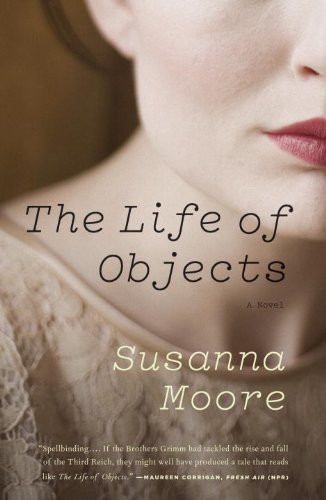
The Life of Objects
کتاب های مرتبط
- اطلاعات
- نقد و بررسی
- دیدگاه کاربران
نقد و بررسی

August 6, 2012
In Moore’s (In the Cut) latest novel, objects have complicated lives—they’re bought, collected, requisitioned, buried, stolen, sold, and bartered—and so do people. It’s Germany during WWII, and strange and awful occurrences are becoming common. Even the rich and politically connected Felix and Dorothea Metzenburg can no longer guarantee their safety—or that of Beatrice Palmer, the book’s narrator, who, in a series of unlikely circumstances, has come from Ireland to work for them. The bulk of the story takes place on Dorothea’s country estate, to which the family, with 23 wagons of Felix’s art and objects, retreat when Berlin becomes untenable. There the war switches between a distant rumor on illegal radio broadcasts and, with food shortages, disappearances, and bombings, a reality. It becomes clear that Felix’s moral and aesthetic sensibilities will not allow him to cooperate with the National Socialist state. Although the book starts slowly, once we’re accustomed to Beatrice’s measured style, she’s an appealing, sometimes touching guide to a world where luxury and devastation coexist; friends may be spies; a Cranach painting means less than the potatoes it buys; all kinds of refugees seek safety on the estate; relationships change; and safety, although not love, is illusory. Agent: Stephanie Cabot, the Gernert Agency.

September 1, 2012
Moore (The Big Girls, 2007, etc.) focuses a narrow flashlight on World War II, specifically the daily struggles of an aristocratic couple that remains in Germany despite abhorring the Third Reich. In 1938 County Mayo, bookish 18-year-old Beatrice is desperate to escape her humdrum life. So she is thrilled when a visiting German countess, impressed by Beatrice's lace work, offers to take her to Berlin as a lace maker for the fabulously wealthy Metzenburgs. Countess Inez is unaware that the German government, angry with Felix Metzenburg for refusing an ambassadorship, has requisitioned the Metzenburgs' elegant home. Soon, they decamp to their rural estate with their fabulous collection of art and objects in tow, along with Beatrice and a couple of their most loyal retainers. For the next seven years, Beatrice bears witness as the Metzenburgs attempt a life of grace despite the war. At first, it is hard to tell whether Felix is a man of scruples or just "exquisite taste" and extremely good manners. But details accrue: his protection of the Jewish intellectual who teaches German to a smitten Beatrice, the odd mix of guests who pass through, the treasures he hides for friends and those he trades for food, the refugees he takes in. By the time conquering Soviets take Felix away for questioning, he has become a saintly figure in Beatrice's eyes. Meanwhile, Felix's devoted wife, Dorothea, whose Jewish heritage is an open secret, becomes a tough survivor, as does Beatrice herself. And then there's Inez, captivating but elusive. Actually Cuban (and Felix's former lover), she divorces her German count for an Egyptian prince but continues to flitter in and out of Germany. Maddeningly selfish and superficial but surprisingly generous, she leaves Beatrice wondering, is she WWII-era Eurotrash or a skillful spy? Moore's subject is rectitude. Even when the subject matter is graphically horrendous, the narration remains as reserved and understated as the Metzenburgs, who prefer not to reveal how deeply they feel, how willingly they sacrifice, how daringly they risk.
COPYRIGHT(2012) Kirkus Reviews, ALL RIGHTS RESERVED.

April 15, 2012
In this latest from Moore, who should be better known, Irish Protestant lace maker Beatrice leaves behind her ordinary existence when she's asked to join the elegant and aristocratic Metzenburg household in Berlin. Lucky Beatrice--except that this is the 1930s, and soon she is not living a fairy tale but bearing witness to atrocity.
Copyright 2012 Library Journal, LLC Used with permission.

September 1, 2012
Seventeen-year-old lace maker Beatrice Palmer is overjoyed when she gets the chance to leave her suffocating hometown in Ireland to become a seamstress for a prominent German family. The year is 1938, and Beatrice arrives to find that the Metzenburgs' Berlin home has been requisitioned by the chancellery and most of their servants conscripted. Felix, an art collector and former ambassador, and his wife, Dorothea, the daughter of a Jewish banker and a German baroness, leave with 20 wagons of paintings, silver, and furniture to live quietly at Dorothea's estate 40 miles south of Berlin. But within a few years, the refined Metzenburgs, appalled by Hitler's actions yet unwilling to leave their beloved country, find themselves reduced to living in the forest, sharing what little food they have with the local villagers. The war's end brings little relief as the Red Army and thousands of refugees descend on the countryside. Award-winning author Moore delivers a heartrending portrait of the ravages of war, which is all the more poignant for Beatrice's dispassionate narration. An elegant and moving tribute to the endurance of the human spirit.(Reprinted with permission of Booklist, copyright 2012, American Library Association.)

























دیدگاه کاربران